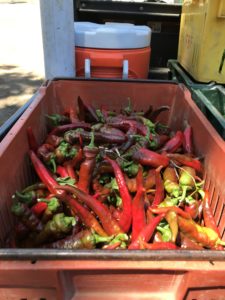We are having some very hot days here at the farm, an experience that we share with other inland Californians. The heat is bringing on the produce. Trucks and trailers full of melons, eggplants, peppers, beans and other delicious summer treats are driving along the farm’s dirt roads, from the fields and to the packing shed, in a parade that reaches a crescendo at the end of the day as the harvest is completed. It is ‘all hands on deck’ in the packing shed then, when several dozen people finish the last packaging, put produce in the coolers and load trucks. Each day is incredibly detail laden, full of troubleshooting, decision making and continuous attempts to balance multiple needs.


Samples of the new varieties of tomatoes, peppers or eggplants that are ready are brought into the office nested in someone’s T-shirt, found while scouting the fields. Green, orange, red, purple and all the colors of the rainbow are on show. A list of availabilities shows that there are pallets of melons ready for new homes off the farm. This is what the sales team lives for, each summertime of bounty when we can offer up sweet abundance.
The heat and drought inject a sense of uncertainty about the future — Will it rain next winter? Will we damp down our planet-warming activities sufficiently to avoid the worst of climate change? Not that there is any uncertainty about the reality itself, just about our ability to respond. Climate change drove this heat wave and made it hotter than it would have been. Think of the town of Lytton in British Columbia which first suffered the country’s highest-ever temperature (121.3F) and then, the next day burned to the ground in the first week of July as hot, dry and windy conditions pushed a fire through town.
June 2021 was the hottest on record for interior California including the Sierra Nevada and southeastern deserts. There were 175 all-time record high temperatures set in Northern California, Oregon, Washington and Idaho between June 25th and 30th. Hot, dry conditions have all kinds of effects — like the massive population of grasshoppers that is attacking everything green in Oregon and Montana. The drought provides ideal conditions for their eggs to hatch and for the grasshoppers to survive into adulthood. The USDA is engaged in a massive spraying program to attack the grasshoppers, while organic farmers in the landscape are fighting to protect their certification.
Agriculture can be a net sink for greenhouse gasses because of the ability to sequester carbon in soil and plants and also because of the very important opportunities in agriculture to reduce methane and nitrous oxide emissions. The authorities will quibble about some of the details, but one thing is clear. It is critically important right now that we keep plants and especially trees growing on the land. Agriculturally-driven deforestation, the conversion of natural ecosystems to agricultural land, and urbanization are the largest single source of greenhouse gas emissions on the planet.
Each of us can change elements of our lifestyle to reduce our personal climate footprint, but we should also take the present opportunity to encourage change at the federal level. Congress is debating the Climate Stewardship Act and the Agricultural Resilience Act. The legislation would double Farm Bill conservation funding; triple research and extension project funding; and invest in rural and food system resilience over the next ten years. The Climate Stewardship Act would support planting trees and reviving deforested landscapes. The California Climate and Agriculture Network is asking all of us to take action in support of these policies by calling or emailing our Senators and Representatives.
Our great grandkids and future generations of farmers may look back on these times and thank us for peering over the brink and then turning back. If we are organized and strategic, they too will have the opportunity to get sweet summer melons and tomatoes from their local farmer.

Judith Redmond
